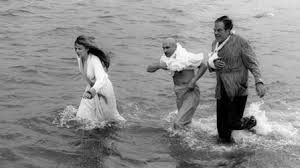Available on Blu-Ray
For a time in the 1960s Roman Polanski seemed the natural successor to Hitchcock. After the triumph of Psycho and The Birds the Master of Suspense went distinctly off the boil. In a world of sex and violence his latter movies looked staid, dated and plain daft. By contrast, Polanski, the French-born, Polish director, caught the zeitgeist and had sudden success with his visually-arresting 1962 Knife in the Water and then he surfaced in Swinging London three years later to release Repulsion with a deranged Catherine Deneuve.
Unlike Hitch, Polanski never liked to repeat himself and Cul-de-Sac is another departure – a moody, bizarre meditation that exploits darkening Northumbrian skies and the craggy silhouette of the holy island of Lindisfarne. Polanski returned to this part of northern England five years later to shoot his super-grisly Macbeth. Cul-de-sac is a journeyman film mixing menace and mind games with comedy and violence (something of a Polanski hallmark) and the result is oddly unnerving. It’s like one of those vintage collectible Polish posters: creepy and kooky in equal measure.
Two mobsters (Lionel Stander and Jack MacGowran; who put the angst into gangster) are on the run and have taken refuge in the fortress-like home of eccentric Donald Pleasance (clearly given free rein by the director) and his nubile missus (Françoise Dorléac, Deneuve’s 25-year-old sister who was to die in a car crash a year after filming Cul-de-Sac). What ensues is funny and frightening, as if Jaques Tati was trying his hand at a dark psychological thriller. A silvery chill runs through the action, helped along by some gloriously atmospheric cinematography from Gilbert Taylor, a hip jazz score (by Komeda) and some arresting pop-surreal moments as when the gangsters’ Morris Minor is marooned on a causeway by the incoming tide.
The prodigiously talented Polanski – he co-wrote the script – confounds expectations throughout. It’s not more pursuing bad guys that appear out of the blue but a party of annoying Little Englanders who take the film off in a new direction. The contrast between the ever-fussing older characters and the beautiful Miss Dorléac (as pouty and insolent as Nico) and her surreptitious lover (Iain Quarrier who looks like David Hemmings’ more beautiful brother) caught snogging in the dunes really encapsulates the fracturing generation gap that cracked open in the mid-1960s. It’s the gap between rock’n’roll and pop, between Lucky Strikes and LSD, beatnik and hippie and… Hitchcock and Polanski.
